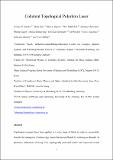Files in this item
Coherent topological polariton laser
Item metadata
| dc.contributor.author | Harder, Tristan H. | |
| dc.contributor.author | Sun, Meng | |
| dc.contributor.author | Egorov, Oleg A. | |
| dc.contributor.author | Vakulchyk, Ihor | |
| dc.contributor.author | Beierlein, Johannes | |
| dc.contributor.author | Gagel, Philipp | |
| dc.contributor.author | Emmerling, Monika | |
| dc.contributor.author | Schneider, Christian | |
| dc.contributor.author | Peschel, Ulf | |
| dc.contributor.author | Savenko, Ivan G. | |
| dc.contributor.author | Klembt, Sebastian | |
| dc.contributor.author | Höfling, Sven | |
| dc.date.accessioned | 2022-04-12T23:46:15Z | |
| dc.date.available | 2022-04-12T23:46:15Z | |
| dc.date.issued | 2021-04-13 | |
| dc.identifier | 273792060 | |
| dc.identifier | cbaf8255-2253-4951-9541-ad6ccfb20bf8 | |
| dc.identifier | 85105058466 | |
| dc.identifier | 000655261600016 | |
| dc.identifier.citation | Harder , T H , Sun , M , Egorov , O A , Vakulchyk , I , Beierlein , J , Gagel , P , Emmerling , M , Schneider , C , Peschel , U , Savenko , I G , Klembt , S & Höfling , S 2021 , ' Coherent topological polariton laser ' , ACS Photonics , vol. Articles ASAP . https://doi.org/10.1021/acsphotonics.0c01958 | en |
| dc.identifier.issn | 2330-4022 | |
| dc.identifier.other | ArXiv: http://arxiv.org/abs/2005.14546v1 | |
| dc.identifier.uri | https://hdl.handle.net/10023/25177 | |
| dc.description | Funding: The Würzburg group acknowledges support from the DFG through the Würzburg-Dresden Cluster of Excellence on Complexity and Topology in Quantum Matter “ct.qmat” (EXC 2147, project‐id 39085490) and the doctoral training program “Elitenetzwerk Bayern". S.H. acknowledges support by the EPSRC ”Hybrid Polaritonics” Grant (EP/M025330/1). M.S., I.V. and I.G.S acknowledge the support by the Institute for Basic Science in Korea (Project No.~IBS-R024-D1). T.H. acknowledges support by the German Academic Scholarship Foundation. | en |
| dc.description.abstract | Topological concepts have been applied to a wide range of fields in order to successfully describe the emergence of robust edge modes that are unaffected by scattering or disorder. In photonics, indications of lasing from topologically protected modes with improved overall laser characteristics were observed. Here, we study exciton-polariton microcavity traps that are arranged in a one-dimensional Su-Schrieffer-Heeger lattice and form a topological defect mode from which we unequivocally observe highly coherent polariton lasing. Additionally, we confirm the excitonic contribution to the polariton lasing by applying an external magnetic field. These systematic experimental findings of robust lasing and high temporal coherence are meticulously reproduced by a combination of a generalized Gross-Pitaevskii model and a Lindblad master equation model. Thus, by using the comparatively simple SSH geometry, we are able to describe and control the exciton-polariton topological lasing, allowing for a deeper understanding of topological effects on microlasers. | |
| dc.format.extent | 1558344 | |
| dc.language.iso | eng | |
| dc.relation.ispartof | ACS Photonics | en |
| dc.subject | Exciton-polariton | en |
| dc.subject | Polariton condensation | en |
| dc.subject | Topological lasing | en |
| dc.subject | Su-Schrieffer-Heeger | en |
| dc.subject | Coherence | en |
| dc.subject | QC Physics | en |
| dc.subject | QD Chemistry | en |
| dc.subject | TK Electrical engineering. Electronics Nuclear engineering | en |
| dc.subject | 3rd-DAS | en |
| dc.subject.lcc | QC | en |
| dc.subject.lcc | QD | en |
| dc.subject.lcc | TK | en |
| dc.title | Coherent topological polariton laser | en |
| dc.type | Journal article | en |
| dc.contributor.sponsor | EPSRC | en |
| dc.contributor.institution | University of St Andrews. School of Physics and Astronomy | en |
| dc.contributor.institution | University of St Andrews. Condensed Matter Physics | en |
| dc.identifier.doi | 10.1021/acsphotonics.0c01958 | |
| dc.description.status | Peer reviewed | en |
| dc.date.embargoedUntil | 2022-04-13 | |
| dc.identifier.grantnumber | EP/M025330/1 | en |
This item appears in the following Collection(s)
Items in the St Andrews Research Repository are protected by copyright, with all rights reserved, unless otherwise indicated.

